|
On
November 6, 1919, at a meeting of Britain’s scientific elite, Arthur
Eddington (not yet Sir) stood beneath a 30-foot portrait of Sir Isaac
Newton and presented the first evidence that gravity bends starlight,
confirming Einstein’s theory of General Relativity and disproving
Newton’s theory of gravity, which had been the gold standard of science
for over two centuries.
Images
taken during the 1919 solar eclipse by Eddington and his colleagues
proved the light of distant stars passing near the Sun is deflected by
its gravity, as sketched here.
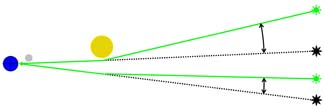 The
green lines show the actual paths of light from two stars that bend as
they pass the Sun, which are only visible on Earth (blue) when the Moon
(gray) blocks the Sun (yellow). The lower starlight passes twice as far
from the Sun’s center as the upper starlight, and therefore bends half
as much. The two black stars are at the apparent positions we
observe when the Sun bends their light. When Earth moves to the other
side of the Sun, we observe the stars in their true positions (shown in
green). The
green lines show the actual paths of light from two stars that bend as
they pass the Sun, which are only visible on Earth (blue) when the Moon
(gray) blocks the Sun (yellow). The lower starlight passes twice as far
from the Sun’s center as the upper starlight, and therefore bends half
as much. The two black stars are at the apparent positions we
observe when the Sun bends their light. When Earth moves to the other
side of the Sun, we observe the stars in their true positions (shown in
green).
Eddington
was a well-known proponent of General Relativity. After he presented
his eclipse images, a reporter asked him if it were true that only three
people in the world understood General Relativity. After a lengthy
pause, Eddington replied: “I’m just trying to think who the third person
is.”
In various situations, the bending of light by massive bodies — now called gravitational lensing
— can magnify light intensity, produce multiple images of one source,
grossly distort images, and shift their apparent position.
In the 100 years since its first discovery, gravitational lensing has become a powerful tool for revealing the hidden universe.
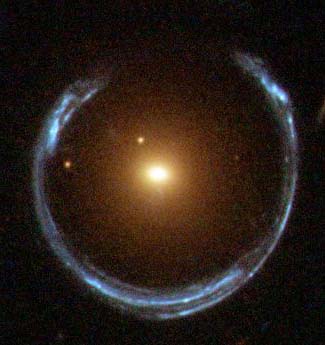 This image on the right shows an Einstein Ring.
The central yellow galaxy, 5 billion light-years away with a mass of 5
trillion Suns, focuses light from a blue galaxy that is 10 billion
light-years away. The blue galaxy’s true shape is distorted into a
nearly circular blue arc. This image on the right shows an Einstein Ring.
The central yellow galaxy, 5 billion light-years away with a mass of 5
trillion Suns, focuses light from a blue galaxy that is 10 billion
light-years away. The blue galaxy’s true shape is distorted into a
nearly circular blue arc.
Gravitational
lensing has also revealed exoplanets, planets orbiting other stars. The
OGLE chart below plots the light intensity versus time of a distant
source as an intervening star and nearby planet pass through our line of
sight to the source.
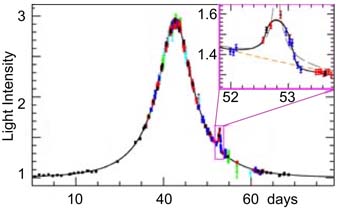 Lensing
by the star triples the intensity of light reaching us from the remote
source (at day 43), while the planet increases intensity by about 20%
just before day 53. The intensity enhancement improves with better
alignment of source, lens, and Earth — the greatest observed
enhancement exceeds several hundred times. Lensing
by the star triples the intensity of light reaching us from the remote
source (at day 43), while the planet increases intensity by about 20%
just before day 53. The intensity enhancement improves with better
alignment of source, lens, and Earth — the greatest observed
enhancement exceeds several hundred times.
Galaxies
and galaxy clusters are often highly asymmetric lenses that produce
multiple images of one object. The picture on the left in the image
below shows two images (“A” above and “B” below) of a quasar 9 billion
light-years away, produced by a lensing galaxy 4 billion light-years
away, seen near B. The emission spectra of A and B are nearly identical,
confirming that these are two images of one object.
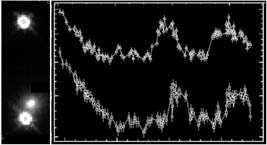 Quasars
are intensely radiating supermassive black holes. As shown in the
right-hand graphs, radiation from this quasar varies in intensity
(vertically) over time (horizontally). Changes in B lag similar changes
in A by about 400 days, revealing a travel time difference between the
light focused at A versus B. Quasars
are intensely radiating supermassive black holes. As shown in the
right-hand graphs, radiation from this quasar varies in intensity
(vertically) over time (horizontally). Changes in B lag similar changes
in A by about 400 days, revealing a travel time difference between the
light focused at A versus B.
Remarkably,
gravitational lensing even reveals mass that is invisible. The famous
Bullet Cluster image is compelling evidence for the existence of dark
matter. It shows two galaxy clusters 150 million years after they
collided. The larger cluster circled in green and the smaller cluster
circled in yellow, with total mass 1000 trillion Suns, passed through
one another at 6 million mph, 3.4 billion light-years from Earth.
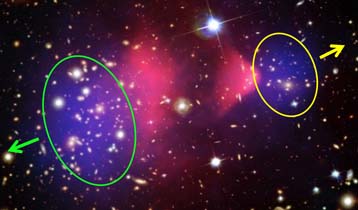 Being
mostly empty space, the galaxies were almost unaffected. The two plasma
clouds (ionized gas shown in pink) in which the galaxies were embedded
interacted strongly, reducing their speed and producing the wedge-like
shock front on the right. The purple clouds represent dark matter,
reconstructed by computer analysis of gravitational lensing of even more
remote sources. The plasma mass far exceeds the mass of visible stars,
but their sum is not nearly enough to account for the observed lensing.
An invisible mass far greater than the visible mass must account
for this amount of lensing. Being
mostly empty space, the galaxies were almost unaffected. The two plasma
clouds (ionized gas shown in pink) in which the galaxies were embedded
interacted strongly, reducing their speed and producing the wedge-like
shock front on the right. The purple clouds represent dark matter,
reconstructed by computer analysis of gravitational lensing of even more
remote sources. The plasma mass far exceeds the mass of visible stars,
but their sum is not nearly enough to account for the observed lensing.
An invisible mass far greater than the visible mass must account
for this amount of lensing.
Since
the dark matter aligns with the galaxies and not with the plasma, we
know it too was unaffected by the collision, proving that dark matter
interacts with normal matter and with other dark matter only
gravitationally — an essential insight only gravitational lensing can
provide.

Best Regards,
Robert
January 2020
Note: Previous newsletters can be found on my website.
|